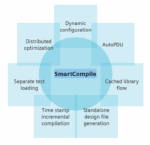The demand for higher performance, greater configurability, and more cost-effective solutions is pushing the industry toward heterogeneous integration and 3D integrated circuits (3D ICs). These solutions are no longer reserved for niche applications—they are rapidly becoming essential to mainstream semiconductor design.… Read More
Scaling 3D IC Technologies – Siemens Hosts a Meeting of the Minds at DAC
3D IC was a very popular topic at DAC. The era of heterogeneous, multi-chip design is here. There were a lot of research results and practical examples presented. What stood out for me was a panel at the end of day two of DAC that was hosted by Siemens. This panel brought together an impressive group of experts to weigh in on what was really… Read More
Siemens Proposes Unified Static and Formal Verification with AI
Given my SpyGlass background I always keep an eye out for new ideas that might be emerging in static and formal verification. Whatever can be covered through stimulus-free analysis reduces time that needn’t be wasted in dynamic analysis, also adding certainty to coverage across that range. Still, advances don’t come easily. … Read More
Protecting Sensitive Analog and RF Signals with Net Shielding
By Hossam Sarhan
Communication has become the backbone of our modern world, driving the rapid growth of the integrated circuit (IC) industry, particularly in communication and automotive applications. These applications have increased the demand for high-performance analog and radio frequency (RF) designs.
However, designing… Read More
Improve Precision of Parasitic Extraction for Digital Designs
By Mark Tawfik
Parasitic extraction is essential in integrated circuit (IC) design, as it identifies unintended resistances, capacitances, and inductances that can impact circuit performance. These parasitic elements arise from the layout and interconnects of the circuit and can affect signal integrity, power consumption,… Read More
Revolutionizing Simulation Turnaround: How Siemens’ SmartCompile Transforms SoC Verification
In the race to deliver ever-larger SoCs under shrinking schedules, simulation is becoming a bottleneck. With debug cycles constrained by long iteration times—even for minor code changes—teams are finding traditional flows too rigid and slow. The problem is further magnified in continuous integration and continuous deployment… Read More
Siemens EDA Unveils Groundbreaking Tools to Simplify 3D IC Design and Analysis
In a major announcement at the 2025 Design Automation Conference (DAC), Siemens EDA introduced a significant expansion to its electronic design automation (EDA) portfolio, aimed at transforming how engineers design, validate, and manage the complexity of next-generation three-dimensional integrated circuits (3D ICs).… Read More
Jitter: The Overlooked PDN Quality Metric
Bruce Caryl is a Product Specialist with Siemens EDA
The most common way to evaluate a power distribution network is to look at its impedance over the effective frequency range. A lower impedance will produce less noise when transient current is demanded by the IC output buffers. However, this transient current needs to be provided… Read More
DAC News – A New Era of Electronic Design Begins with Siemens EDA AI
AI is the centerpiece of DAC this year. How to design chips to bring AI algorithms to life, how to prevent AI from hacking those chips, and of course how to use AI to design AI chips. In this latter category, there were many presentations, product announcements and demonstrations. I was impressed by many of them. But an important observation… Read More
Podcast EP293: 3DIC Progress and What’s Coming at DAC with Dr. John Ferguson and Kevin Rinebold of Siemens EDA
Dan is joined by Dr. John Ferguson, Director of Product Management for the Calibre nmDRC and 3DIC related products for Siemens EDA. John has worked extensively in the area of physical design verification. Holding several patents, he is also a frequent author in the physical design and verification domain. Current activities … Read More









